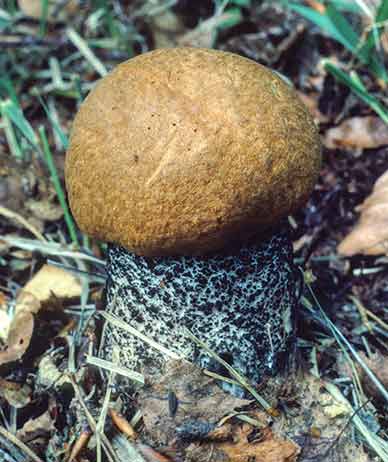Orange Birch Bolete (Leccinum versipelle)

under birch, near the Park Pale
The Orange Birch Bolete, one of a number of similar, closely related species, is relatively common and widespread in autumnal New Forest woodlands. Almost needless to say, it grows under birch trees.
The cap, brownish-orange in colour, can extend to 20 centimetres across, but is usually considerably smaller, and has a margin that quite distinctly overhangs the pores.
Similarly, the sturdy stem, swollen towards the base, can achieve a height of 20 centimetres, but is generally considerably shorter. As with that of its close relatives, it is white or greyish in colour, and covered with browny-black scales. Pores are small and grey initially, later becoming pale, brownish yellow and bruising wine red.
This is an edible species that is very good to eat, but to be absolutely sure of identification, it is usually suggested that the fungus should be cut in half, the flesh bruised and left for up to 20 minutes and any colour change noted.
(The flesh of the Orange Birch Bolete when cut goes pinkish, then blue-grey and finally blackish; whilst the tubes, initially white then buff, turn a pale wine-red).
Warning: refer to a good, comprehensive fungus field guide to confirm identification, and only eat those species known without any doubt whatsoever to be edible - people have died after eating certain poisonous specimens.
References:
Mushrooms and other Fungi of Great Britain and Europe - Roger Phillips
The Mushrooms and Toadstools of Britain and North-western Europe - Marcel Bon
Fungi of Britain and Europe - Stefan Buczacki and John Wilkinson
The MacDonald Encyclopedia of Mushrooms and Toadstools - Giovanni Pacioni
Fungi of the New Forest: A Mycota - Edited by Gordon Dickson and Ann Leonard
A Passion for Mushrooms - Antonio Carluccio
More links
Other related links
Search this site

Sadly, 58 animals were killed - 35 ponies, 13 cows, 8 donkeys and 2 sheep, whilst a further 32 were injured - 3 pigs, 9 donkeys, 11 cows and 9 ponies.
(Forty-three accidents occurred in daylight, 15 at twilight and 101 in the dark. Twenty-seven accidents were not reported by the driver involved).
Here's just one horrific example - Three donkeys killed in collision with van at notorious New Forest blackspot (Advertiser and Times)

